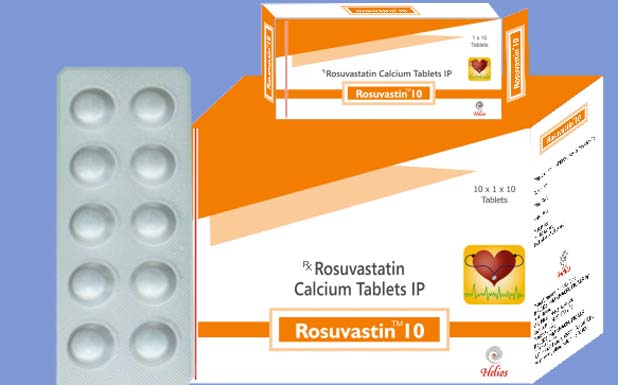Indications and Usage:
● Used for treatment of dyslipidemia
● Enzyme inhibitor
● Used for treatment of high LDL cholesterol The primary uses of rosuvastatin is for the treatment of dyslipidemia. Rosuvastatin is a competitive inhibitor of the enzyme HMG-CoA reductase, having a mechanism of action similar to that of other statins. Rosuvastatin is approved for the treatment of high LDL cholesterol (dyslipidemia), total cholesterol (hypercholesterolemia), and/or triglycerides (hypertriglyceridemia). It may also be used to prevent certain types of heart and blood vessel problems in patients with risk factors for heart problems.
Drug Interaction and Mechanism of Action:
When administered with cyclosporine, the blood level of rosuvastatin increases seven fold, and this could increase the side effects of rosuvastatin. Rosuvastatin increases the action of the blood thinner warfarin (Coumadin) and could increase the risk of bleeding from warfarin.
Antacids reduce the absorption of rosuvastatin and should be administered two hours after rosuvastatin.
Rosuvastatin is a competitive inhibitor of the enzyme HMG-CoA reductase, having a mechanism of action similar to that of other statins. Its approximate elimination half life is 19 h and its time to peak plasma concentration is reached in 3-5 h following oral administration. Putative beneficial effects of rosuvastatin therapy on chronic heart failure may be negated by increases in collagen turnover markers as well as a reduction in plasma coenzyme Q10 levels in patients with chronic heart failure.
Pharmacological:
A new glucocorticoid deflazacort is a D-ring substituted steroid.It is a synthetic oxazoline derivative of prednisolone, having the molecular formula11beta, 21-dihydroxy-2'-methyl-5'beta-H-pregna-1, 4-dieno [17,16d] oxazole-3, 20-dione-21-acetate.
Pharmacodynamic:
Rosuvastatin is a member of the drug class of statins, used to treat high cholesterol and related conditions, and to prevent cardiovascular disease.
Pharmacokinetic:
Absorption:Bioavailability is approximately 20%
Volume of Distribution 134 L
Protein Binding: 90% bound to plasma proteins (mostly albumin)
Metabolism: Not extensively metabolized. Only ~10% is excreted as metabolite. Cytochrome P450 (CYP) 2C9 is primarily responsible for the formation of rosuvastatin's major metabolite, N-desmethylrosuvastatin. N-desmethylrosuvastatin has approximately 50% of the pharmacological activity of its parent compound in vitro. Rosuvastatin accounts for greater than 87% of the pharmacologic action. Inhibitors of CYP2C9 increase the AUC by less than 2-fold. This interaction does not appear to be clinically significant.
Route of Elimination: Rosuvastatin is not extensively metabolized; approximately 10% of a radiolabeled dose is recovered as metabolite. Following oral administration, rosuvastatin and its metabolites are primarily excreted in the feces (90%).
Side Effects:
●Severe Stomach
●Abdominal pain
●Persistent nausea
●Vomiting
●Dizziness
Contraindications:
● Hypersensitivity to drug or its components
● Active hepatic disease or persistent, unexplained hepatic enzyme elevations
● Pregnancy or breastfeeding
Storage:
Store at room temperature away from light and moisture.
